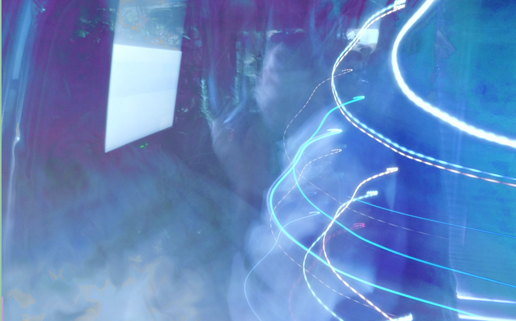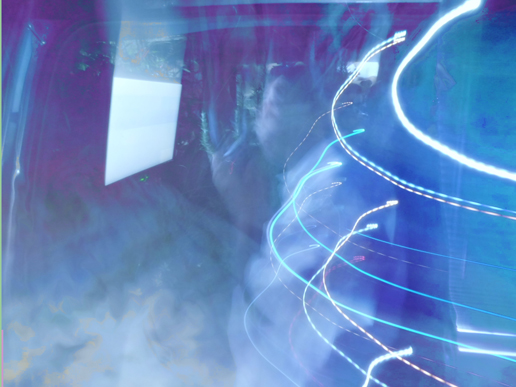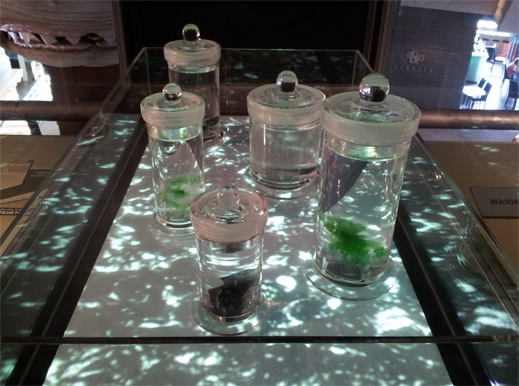
Curated by Ian Clothier with an advisory panel of Nina Czegledy, Tengaruru Wineera and Trudy Lane, a bridge between Maori and European cultures of Aotearoa New Zealand has been constructed. The cultural bridge interconnects both Maori and European knowledge at the level of summary. Five themes from within European and Maori world views were located.
Given the intercultural bridge, works from art and science are recontextualised as cultural texts symbolic of belief systems. Discipline is not viewed as fixed, but fluid in a transformational environment. In the exhibition, digital and post-digital exist in a state of hybridity.
The project began with the selection of concepts shared across ideological borders. The topics were loosely connected and include cosmological context, all is energy, life emerged from water, anthropic principle and integrated systems. All the selected works address more than one of these thematic regions.
Discipline boundaries were breached, following a course charted at SCANZ 2011: Eco sapiens where artists, scientists, environmentalists, activists, educationalists, philosophers and tangata whenua came together to collectively re-imagine our narratives on nature. In this way the event sought to encourage cultural shifts in response to the environmental crisis facing earth and humanity.
Breaching boundaries of culture and discipline, generating cultural hybridity and interdisciplinarity has consequences. There are gains and losses in the approach, but what might be won is a way forward that is sustainable, affirmative and interconnected. One sense of the term ‘culture’ refers to customary practice or a way of thinking, while one sense of ‘discipline’ is method – in these senses of those words, the works here arise from a culture of sharing and a discipline of openness.
Curator – Ian Clothier CV and bio
Ian Clothier is Director of Intercreate Research Centre (intercreate.org) and Founder and Co-director of SCANZ residency, symposium and exhibition. As an artist his projects intersect art, technology, science and culture. Recent creative projects include the integrated systems The Park Speaks and Haiku robots; and the hybrid cultural Making History a project of his internet micronation The District of Leistavia. He has had thirteen solo shows and been selected for exhibition at institutions in twelve countries including three ISEA exhibitions: ISEA 2009 Belfast exhibition; Taranaki culture at Puke Ariki, New Zealand; ISEA 2008 Singapore symposium; net.NET at The JavaMuseum; for Finger Lakes Environmental Film Festival in the USA (upstate New York); ISEA 2006 San Jose exhibition; Graphite at the University of Otago NZ; the First International Festival of Electronic Art in Rio de Janeiro; Fair Assembly at ZKM; New Forms Festival in Vancouver; ISEA 2004 Tallinn/Helsinki exhibition; ReJoyce in Dublin and Wild 2002 in the Tasmanian Museum. He was awarded a Converge Artist Fellowship at the University of Canterbury in 2005 for an augmented reality project. Written work has been published in respected journals, Leonardo, Convergence and Digital Creativity and he has delivered papers to conferences and symposia worldwide.
Curatorial experience includes being selection panel member for Solar Circuit Aotearoa New Zealand 2006; SCANZ 2009: Raranga Tangata; SCANZ 2011: Eco sapiens; Inter:place at Puke Ariki 2010; WITT-wide an exhibition covering work by staff of all departments of Taranaki’s polytechnic in 2009; Interactive City selection panel for ISEA 2006; Exhibitions, Policy and Education Officer, The Gallery Akaroa 1990 – 1992; Co-director of Summer Entertainment in Akaroa 1986; and Exhibition Officer 1984-86 at the Gallery Akaroa.
As well as curatorial panel membership he also produced and creatively directed the SCANZ events with Trudy Lane. Previously he had been Special Projects Manager at the University of Auckland Business School (managing world class teaching technology installations 1997-2002), and Survey Manager for Halcrow Fox Associates in the UK 1988-1990). In 2002 he was awarded and MA (Hons) from AUT, and has a Diploma of Art in Visual Arts from Monash University Gippsland Campus.
Research Publications
Clothier, I (2009). The Collaborative Landscape: some insights into current practice in the visual arts ITPQ refereed conference proceedings.
Clothier, I (2008). Leonardo, nonlinearity and integrated systems in Leonardo Volume 41 Number 1 pp. 49-55.
Clothier, I. & Lane, T. (2008). Solar Circuit Aotearoa New Zealand in S. Brennan & S. Ballard (Eds.) The Aotearoa Digital Arts Reader. Auckland: Clouds.
Clothier, I. & Lane, T. (2008). SCANZ. New Plymouth: Intercreate Press. ISBN 978-0-473-13388-7.
Clothier, I. (2007). Formen der Reprasentation: Hybride Kulturen, Nonlinearitat und creative Verfahren (Forms of Representation: Hybrid Culture, Nonlinearity and Creative Practice). In Kroncke, M; Mey, K & Spielmann, Y. (Eds.) Kultureller Umbau: Räume, Identitäten, Re/Präsentationen (Cultural Reconstruction: Spaces, Identities, Re/Presentations). Bielefeld: Transcript. ISBN 978-3-89942-556-7.
Clothier, I (2007). Created identities: hybrid cultures and the internet (revised with images) at http://www.hz-journal.org/n11/clothier.html
Clothier, I. (2007). Art.data/branching. New Plymouth: Intercreate Press. ISBN 978-0-473-11915-7.
Clothier, I. (2005). Created identities: hybrid cultures and the internet in Convergence Volume 11 Number 4 p 44-59; London, Thousand Oaks and New Delhi:Sage Publications
Clothier, I. (2003). Hybrid cultures: what, where and how about us? Nga Waka, Aotearoa NZ Association of Art Educators Conference published in Nga Waka, ANZAAE refereed conference proceedings, Vol. One (1),2003
Clothier, I. (2001). From chaos and cosmology: a new space for the visual arts in Digital Creativity Volume 12 no. 1, p 31-44.























